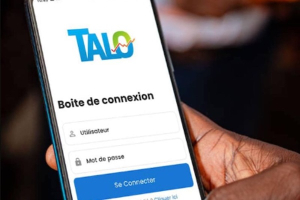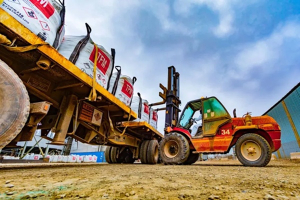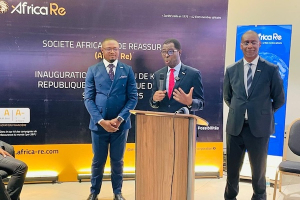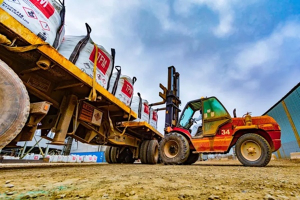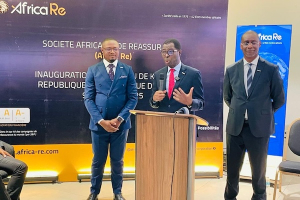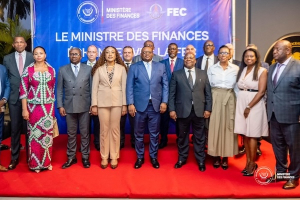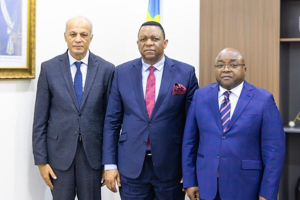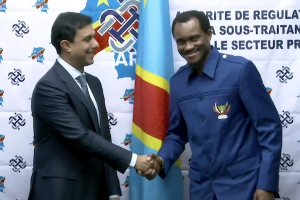Equipe Publication
Talo, DRC's Homegrown Price Watchdog, to Begin National Rollout to 13 Cities
The TALO price-control app is scheduled to begin its rollout in November across several cities in the Democratic Republic of Congo (DRC). The announcement was made on Tuesday, October 7, 2025, by Minister of National Economy Daniel Mukoko Samba during an interview on Kinshasa-based Top Congo FM.
The minister said the first phase will cover seven major cities, with six more to follow by year-end. The goal is to enable real-time tracking of prices for food and other staple consumer goods.
Developed by young Congolese professionals, TALO was unveiled by Minister Mukoko Samba on January 14, 2025. Designed to modernize the economic inspection service, the app helps field agents collect data more efficiently and increases transparency in business practices for consumers.
In Kinshasa, where the application is already in use, TALO has replaced manual price reporting. Agents now record data on their phones at market sites and send it directly to a central database. According to Jocelyne Mayungu Bwanga, head of the Kinshasa-East office at the Ministry of National Economy, the switch to digital data collection has significantly reduced processing times.
The ministry posts monthly reports on its official website summarizing the data. The latest report, for July, showed that weekly price tracking in Kinshasa covered 39 staple consumer products, 183 brands, and 62 types of traders across 16 markets, including Central, Gambela, Zigida, and Liberté.
Price differences of up to 40% were sometimes observed for the same product between different outlets. To identify the underlying causes, the ministry has commissioned a Congolese consulting firm to conduct a study. One preliminary finding points to two main supply routes: goods entering through the Lufu border with Angola tend to be cheaper than those coming via Matadi port.
By expanding TALO to the provinces, the Ministry of National Economy aims to strengthen its nationwide price-monitoring and regulatory capacity. The ultimate goal is to curb market speculation and protect consumers’ purchasing power.
Timothée Manoke
In DRC Cobalt Quota Shake-Up, CMOC Wins the Largest Share—And a Major Headache
The Strategic Mineral Substances Markets Regulation and Control Authority (Arecoms) finalized the practical terms for implementing the Democratic Republic of Congo's (DRC) new cobalt export quota policy on October 10, 2025. The policy was first announced on September 20.
The quotas, approved by the Arecoms Board, allocate export volumes for the last quarter of 2025 to 21 companies.
China's CMOC Group, the world's largest cobalt producer, was granted 6,500 tons,4,250 tons for its Kisanfu Mining (KM) subsidiary, and 2,250 tons for Tenke Fungurume Mining (TFM). This total represents nearly 36% of the global volume allocated. Glencore follows with 3,925 tons, split between 2,775 tons for Kamoto Copper Company (KCC) and 1,150 tons for Mutanda Mining (MUMI). Combined, the two foreign giants capture 58% of the available quotas.
This dominance is rooted in the allocation formula. The Arecoms document specifies that "the base quota is distributed pro rata based on the historical quantities exported between January 1, 2022, and December 31, 2024." Exemptions were made for the state-owned Entreprise générale du cobalt (EGC) and the Société du Terril de Lubumbashi (STL), which were allotted 1,175 tons and 300 tons, respectively. During the 2022-2024 period, CMOC and Glencore controlled nearly 60% of total Congolese cobalt exports.
CMOC, whose primary shareholder is Chinese battery maker CATL, has not yet officially responded to the decision. However, the allocation poses a major challenge for the group, which relies heavily on Congolese cobalt to meet surging demand in China. Its metal trading subsidiary, IXM, already declared force majeure on June 30 due to the initial Congolese export embargo imposed in February 2025.
Despite the export suspension, CMOC maintained its operational pace in the DRC, extracting 61,073 tons in the first half of 2025 and projecting a full-year output of 100,000 to 120,000 tons. With only 6,500 tons authorized for the fourth quarter of 2025 and an estimated 31,200 tons for 2026 (based on the December quota being rolled over), the company will only be able to sell a small fraction of its production. Over two years, its total authorized exports would likely be capped at 37,700 tons, falling far short of its annual capacity.
Even if CMOC were to secure the entirety of the 9,600 tons set aside for "strategic quotas" in 2026, a volume reserved for projects deemed "of national importance" and allocated at Arecoms’ sole discretion,the situation would remain critical for the company.
Enforcement and Market Risk
CMOC also risks having its quotas revoked entirely. Sanctions are prescribed against any company that processes mining tailings or concentrates obtained from unauthorized third parties or artisanal miners, sells its quota to another firm, fails to export the allocated volumes, or violates existing laws.
While the export embargo is scheduled to end on October 15, the resumption of shipments could still face delays. To obtain an export certificate, operators are now required to present proof of prepayment of the mining royalty, validation of their available quota, a traceability certificate issued by Arecoms, and an environmental and fiscal compliance certificate.
Since the imposition of the embargo, the price of cobalt has more than doubled. On October 12, 2025, a tonne of cobalt was trading at $42,725 on the London Metal Exchange, compared to just $21,000 at the end of February.
Pierre Mukoko
Contrôle des prix : l’application TALO bientôt déployée dans 13 villes de RDC
Le ministre de l’Économie nationale, Daniel Mukoko Samba, a annoncé le mardi 7 octobre 2025 sur Top Congo FM que le déploiement de l’application de contrôle des prix TALO débutera dès le mois de novembre dans plusieurs villes de la République démocratique du Congo.
Selon lui, sept grandes villes seront concernées dans une première phase, avant l’ajout progressif de six autres d’ici la fin de l’année. L’objectif est de permettre un suivi en temps réel de l’évolution des prix des biens alimentaires et de grande consommation.
Développée par de jeunes Congolais, TALO avait été officiellement présentée le 14 janvier 2025 par le ministre Mukoko Samba. Conçue pour moderniser le service de contrôle économique, elle facilite le travail des inspecteurs sur le terrain et renforce la transparence des pratiques commerciales au profit des consommateurs.
À Kinshasa, où elle est déjà utilisée, TALO a remplacé le système manuel de collecte des prix. Désormais, les agents se rendent sur les marchés avec des téléphones, saisissent les données sur place et les transmettent directement au système central. Cette numérisation a permis de réduire considérablement les délais de traitement, souligne Jocelyne Mayungu Bwanga, cheffe du bureau Kinshasa-Est au ministère de l’Économie nationale.
Le ministère publie régulièrement des bulletins mensuels sur son site officiel, synthétisant les informations collectées. Le plus récent, celui de juillet, montre qu’à Kinshasa, le suivi hebdomadaire des prix couvre 39 produits de grande consommation, 183 marques et 62 types d’opérateurs, répartis sur 16 sites, dont les marchés Central, Gambela, Zigida et Liberté.
Ces observations révèlent parfois des écarts de prix allant jusqu’à 40 % pour un même produit selon les points de vente. Pour en comprendre les causes, une étude a été confiée à un cabinet de consultance congolais. Une première hypothèse pointe la coexistence de deux grands circuits d’approvisionnement à Kinshasa : les produits entrant via le poste frontalier de Lufu, en provenance d’Angola, affichent des prix plus bas et ceux qui passent par le port de Matadi sont en général plus coûteux.
Avec l’extension de TALO dans les provinces, le ministère de l’Économie veut renforcer sa capacité d’analyse et de régulation à l’échelle nationale. Objectif : lutter plus efficacement contre la spéculation sur les marchés congolais et protéger le pouvoir d’achat des consommateurs.
Timothée Manoke
Lire aussi :
Contrôle des prix et des stocks : l’application TALO, le nouvel outil de la RDC
Africa Re Opens Kinshasa Office in Push for Greater Premium Retention
African Reinsurance Corporation (Africa Re) inaugurated an office in Kinshasa, Democratic Republic of Congo (DRC), on October 9.
According to Africa Re Chairman Moustapha Coulibaly, the new office aims to support local insurance companies in covering major risks and to offer solutions tailored for strategic sectors such as mining, energy, infrastructure, and agriculture.
Coulibaly also emphasized Africa Re's commitment to assisting the Insurance Regulation and Control Authority (Arca) in modernizing the regulatory framework, which is crucial for strengthening the credibility and attractiveness of the Congolese insurance market.
The opening of this office will allow the pan-African reinsurer to work more closely with its local partners to improve the retention of premiums nationally. Losses related to placing premiums abroad and the non-collection of value-added tax (VAT) were estimated at approximately $1.5 billion in 2023, according to Arca.
In accordance with a November 29, 2019, circular from Arca, Congolese insurance companies were already obligated to cede at least 5% of their reinsurance treaties to Africa Re. Building on this relationship, Arca and Africa Re launched the Reinsurance Facility in March 2024, a collective mechanism allowing companies in the same market to pool their risks and strengthen their financial capacity against claims.
This mechanism aims to "provide the DRC with greater national reinsurance capacity and better control over insurance and reinsurance operations, particularly in the oil, gas, mining sectors, and against political violence risks." It also serves to limit the outsourcing of insurance for companies where at least 75% of the risks are located in the DRC, aligning with Arca’s requirements.
Established in 1976 by the African Union and the African Development Bank, Africa Re is a pan-African reinsurance institution dedicated to enhancing the sector's capacity across the continent. In 2024, the company reported $1.21 billion in gross written premiums, representing a 9.73% increase over 2023. Its network now includes 11 offices across Africa, the Middle East, Asia, and Latin America, comprising various subsidiaries and regional offices. In the DRC, Africa Re becomes the second reinsurance player in the market, following the entry of reinsurer Zep-Re.
Ronsard Luabeya
Cobalt : la RDC attribue les quotas, CMOC capte la plus grosse part mais…
L’Autorité de régulation et de contrôle des marchés des substances minérales stratégiques (Arecoms) a fixé, le 10 octobre 2025, les modalités pratiques de mise en œuvre de la politique des quotas à l’exportation du cobalt en République démocratique du Congo (RDC), décidée le 20 septembre dernier. La répartition, arrêtée par le Conseil d’administration de l’Arecoms, concerne 21 entreprises pour le dernier trimestre 2025 (voir tableau ci-dessous).
Le groupe chinois CMOC, premier producteur mondial de cobalt, se voit attribuer 6 500 tonnes : 4 250 pour sa filiale Kisanfu Mining (KM) et 2 250 pour Tenke Fungurume Mining (TFK), soit près de 36 % du volume global. Glencore suit avec 3 925 tonnes, dont 2 775 pour Kamoto Copper Company (KCC) et 1 150 pour Mutanda Mining (MUMI). À eux seuls, les deux groupes captent 58 % des quotas disponibles.
Cette domination s’explique par la grille de calcul. Le texte précise que « le quota de base est distribué au prorata des quantités historiques exportées entre le 1er janvier 2022 et le 31 décembre 2024 », à l’exception de l’Entreprise générale du cobalt (EGC) et de la Société du Terril de Lubumbashi (STL), qui bénéficient d’un traitement particulier avec respectivement 1 175 et 300 tonnes. Sur la période 2022-2024, CMOC et Glencore ont en effet contrôlé près de 60 % des exportations congolaises.
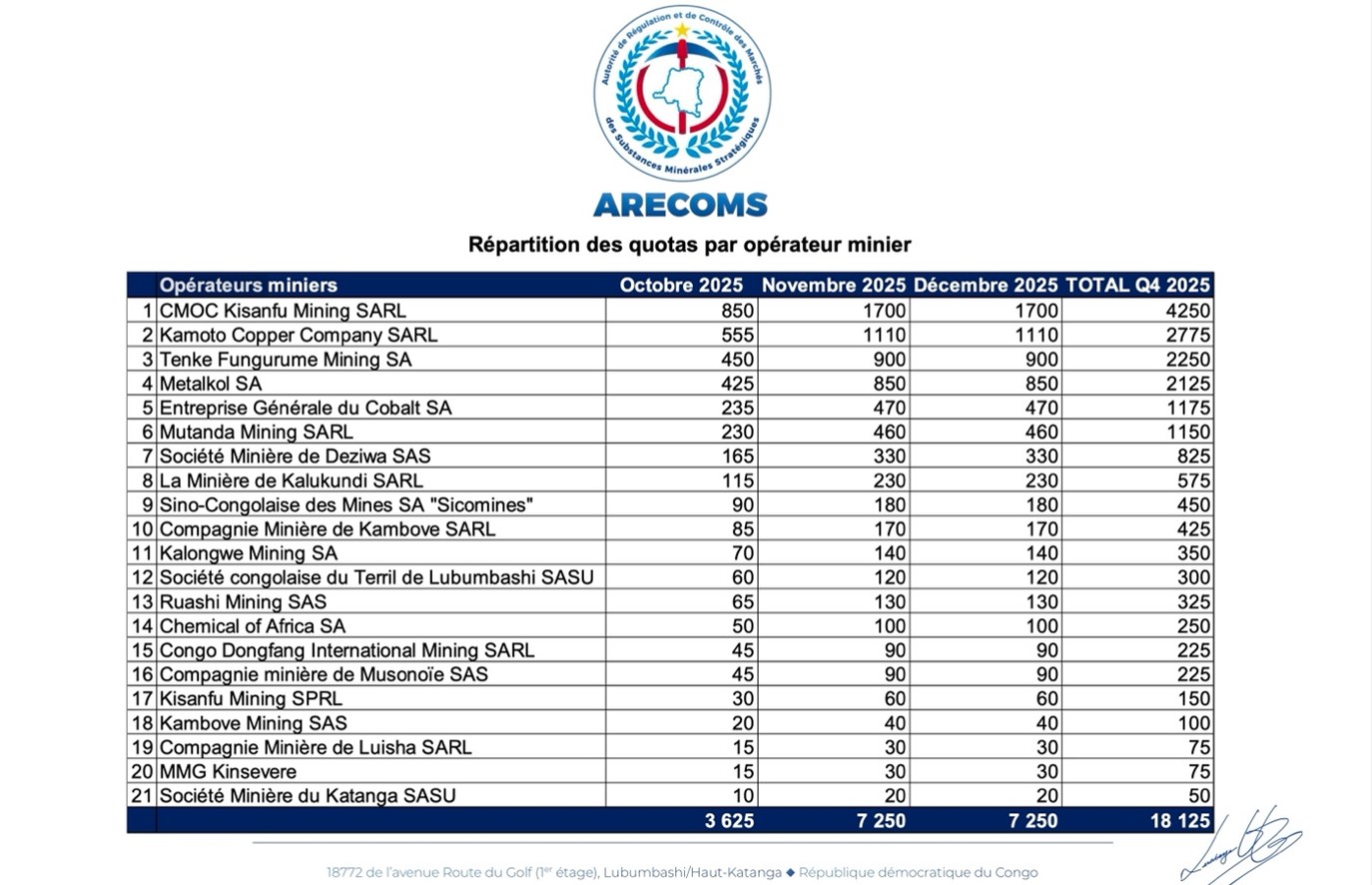
CMOC, dont l’actionnaire principal est le producteur chinois de batteries CATL, n’a pas encore officiellement réagi. Mais cette répartition pourrait s’avérer problématique pour le groupe, très dépendant du cobalt congolais pour répondre à la demande croissante en Chine. Sa filiale IXM, négociant en métaux, avait d’ailleurs déclaré un cas de force majeure le 30 juin dernier, en raison de l’embargo congolais instauré en février 2025.
Malgré la suspension des exportations, CMOC a maintenu sa cadence en RDC avec 61 073 tonnes extraites au premier semestre 2025. Pour l’ensemble de l’année, le groupe anticipe 100 000 à 120 000 tonnes de production. Or, avec seulement 6 500 tonnes autorisées au quatrième trimestre 2025 et 31 200 tonnes pour 2026 (le quota du mois de décembre étant reconduite pour l’année 2026, sauf en cas de non-respect des règles), l’entreprise ne pourra écouler qu’une petite fraction de ses volumes. En deux ans, ses exportations plafonneraient à 37 700 tonnes, bien en deçà de sa production annuelle.
Même en obtenant l’intégralité des 9 600 tonnes de quotas stratégiques prévus en 2026, la situation resterait critique. Cette possibilité reste d’ailleurs incertaine. Réservé aux projets « d’importance nationale », leur attribution relève de la seule discrétion de l’Arecoms.
Risques
Mais CMOC pourrait aussi se voir retirer ses quotas. Cette sanction est prévue contre toute entreprise qui traite des rejets miniers ou concentrés obtenus auprès de tiers ou des artisans, cède son quota à une autre entreprise, s’abstient d’exporter les volumes alloués ou ne respecte pas les lois et règlements en vigueur.
L’embargo doit prendre fin le 15 octobre, mais la reprise des exportations pourrait être retardée. Pour obtenir un certificat d’exportation, les opérateurs devront désormais présenter le reçu de prépaiement de la redevance minière, valider le quota disponible, fournir un certificat de traçabilité délivré par l’Arecoms et un certificat de conformité environnementale et fiscale.
Depuis la mise en place de l’embargo, le cours du cobalt a plus que doublé. Le 12 octobre 2025, la tonne se négociait à 42 725 dollars sur la Bourse des métaux de Londres, contre 21 000 dollars fin février.
Pierre Mukoko
Lire aussi :
Cobalt : le système de quotas toujours incomplet à l’approche de son entrée en vigueur
Cobalt : la RDC fixe ses quotas d’exportation, le chinois CMOC sous pression
Exportations de cobalt : Glencore et CMOC s’opposent sur la ligne à suivre en RDC
Assurances : Africa Re arrive à Kinshasa pour renforcer la rétention locale des primes
La Société africaine de réassurance (Africa Re) a inauguré, le 9 octobre, un bureau à Kinshasa, en République démocratique du Congo (RDC). Selon Moustapha Coulibaly, président du conseil d’administration d’Africa Re, cette implantation vise à soutenir les compagnies d’assurance locales dans la couverture des risques majeurs et à leur offrir des solutions adaptées aux secteurs stratégiques tels que les mines, l’énergie, les infrastructures et l’agriculture.
Moustapha Coulibaly a également souligné la volonté d’Africa Re d’accompagner l’Autorité de régulation et de contrôle des assurances (Arca) dans la modernisation du cadre réglementaire, un levier essentiel pour renforcer la crédibilité et l’attractivité du marché congolais des assurances.
L’ouverture de ce bureau permet au réassureur panafricain de se rapprocher de ses partenaires locaux afin d’améliorer la rétention des primes au niveau national. Les pertes liées au placement des primes à l’étranger et à la non-perception de la taxe sur la valeur ajoutée (TVA) sont estimées à environ 1,5 milliard de dollars, selon l’Arca en 2023.
Conformément à une circulaire de l’Arca du 29 novembre 2019, les compagnies d’assurance congolaises étaient déjà tenues de céder au moins 5 % de leurs traités de réassurance à Africa Re. Dans la même dynamique, l’Arca et Africa Re avaient lancé en mars 2024 la Facilité de réassurance, un mécanisme collectif permettant aux compagnies d’un même marché de mutualiser leurs risques et de renforcer leur capacité financière face aux sinistres.
Ce dispositif vise à « doter la RDC d’une plus grande capacité de réassurance nationale et d’un meilleur contrôle des opérations d’assurance et de réassurance, notamment dans les secteurs pétrolier, gazier, minier et face aux risques liés aux violences politiques ». Il permet également de limiter l’externalisation des assurances pour les entreprises dont au moins 75 % des risques sont localisés en RDC, conformément aux exigences de l’Arca.
Créée en 1976 par l’Union africaine et la Banque africaine de développement, Africa Re est une institution panafricaine de réassurance dont la mission est de renforcer la capacité du secteur sur le continent. En 2024, elle a enregistré 1,21 milliard de dollars de primes brutes souscrites, en hausse de 9,73 % par rapport à 2023. Son réseau compte 11 implantations réparties entre l’Afrique, le Moyen-Orient, l’Asie et l’Amérique latine, comprenant plusieurs filiales et bureaux régionaux. En RDC, Africa Re devient le deuxième acteur du marché de la réassurance après l’installation du réassureur Zep-Re.
Ronsard Luabeya
Lire aussi :
Réforme des assurances: la RDC fait marche arrière, après l’adoption d’un projet de loi
RDC-Chine: une coopération se met en place contre l’évasion des primes d’assurance
Assurance : un marché en croissance en RDC, projeté à plus d’un milliard $ d’ici 10 ans
Congolese Business Leaders Outline Priorities to Finance Minister Fwamba
The first meeting between the Federation of Congolese Enterprises (FEC) and the Minister of Finance, Doudou Fwamba, took place on September 25, 2025, at the Financial Center of Kinshasa. According to the FEC’s report, the employers’ organization, led by Robert Malumba, presented several concerns aimed at improving the business climate in the Democratic Republic of Congo (DRC).
The FEC emphasized the need to renew the moratorium on the fiscal clearance certificate, which expired on September 25, 2025. This measure had been introduced to facilitate certain economic transactions, such as opening bank accounts, granting loans, and signing contracts, while assessing the implementation of the standardized invoice reform. The organization considers a temporary renewal of the moratorium essential to prevent new disruptions in business operations.
The private sector also raised tax-related issues, particularly excise duties on products such as sulfuric acid, beer, and tobacco. The FEC recommended reducing these taxes and denounced the application of deforestation tax to agricultural land. It also highlighted difficulties faced by local industries in Special Economic Zones (SEZs) and called for clarifications to ensure these mechanisms genuinely support domestic production.
The meeting also addressed the allocation of dividends from mining companies. The FEC urged that their use for state benefit be aligned with governance standards, including holding general meetings.
Other topics discussed included the reimbursement of value-added tax (VAT) credits and the need to harmonize national and provincial tax policies. The FEC called for clear alignment to make the tax system predictable and consistent across the country.
In response, Minister Doudou Fwamba announced the creation of a permanent consultation framework with the FEC and the upcoming establishment of a National Fiscal Mediation Commission. This new body will handle disputes between the state and taxpayers, promote dialogue, enhance transparency, and support an inclusive tax reform.
Central Bank of Congo Cuts Rates in Bold Bet on the Franc
After its Monetary Policy Committee (MPC) meeting on October 7, the Central Bank of Congo (BCC) announced a sharp easing of its monetary policy. The benchmark interest rate, which determines the cost at which commercial banks borrow from the central bank, was cut from 25% to 17.5%. The marginal lending facility rate, applied for urgent liquidity needs, was lowered from 30% to 21.5%.
This technical adjustment, the largest since 2021, aims to make financing in Congolese francs (FC) cheaper for commercial banks and, in turn, for the state, businesses, and households. It could encourage lending to economic actors and increase the supply of francs in circulation.
Although not stated explicitly, the BCC’s measures are part of a strategy to restore the role of the franc in domestic transactions and reduce structural dependence on the U.S. dollar, which accounts for over 90% of payments. This is the main objective set by Governor André Wameso since taking office in July.
Behind this monetary goal lies a broader question of sovereignty. Dollar dominance limits the authorities’ ability to manage liquidity and control financial flows. Excessive reliance also exposes the economy to unilateral U.S. decisions, such as potential restrictions on dollar imports. By promoting the use of the Congolese franc, the BCC seeks to reduce external vulnerability and strengthen internal stability as economic fundamentals improve.
According to the MPC, inflation fell from 15.1% in September 2024 to 7.8% a year later, while the national currency appreciated by about 11.6% on the official market and 7.8% on the parallel market, trading at around 2,549 and 2,659 FC per dollar, respectively. For 2026, the BCC forecasts inflation at 6.8%, a more stable exchange rate, and “robust” economic growth.
A Risky Bet
However, the impact of these measures will depend on confidence in the local currency. An increase in the supply of francs without corresponding demand could weaken stability and trigger renewed depreciation.
The DRC’s heavy reliance on imports also poses a major risk. By the end of July 2025, imports had risen by nearly 6%, increasing the need for foreign currency, while exports fell by about 18%, mainly due to suspended cobalt sales. According to the International Monetary Fund (IMF), the faster outflow of foreign currency now represents one of the main risks to maintaining adequate reserves.
Aware of these threats, the BCC said it is ready “to respond in case of a reversal.” To strengthen stability, it plans to absorb excess liquidity by implementing, from October 15, the second stage of the exchange rate adjustment applied to reserve requirements, which has remained fixed at 1,999 FC per dollar since 2021. The governor noted that the first adjustment helped support the franc by withdrawing the equivalent of 371 billion FC from the market.
At the same time, the BCC is encouraging businesses to conduct transactions in francs, while the government plans to collect part of its taxes in the local currency. The rate cut is also expected to help the Treasury refinance domestic debt at lower costs, easing the interest burden on public finances.
DRC’s Industrial Promotion Fund Set to Fully Digitalize Operations by End of 2025
The Industrial Promotion Fund (FPI) plans to launch the production phase of its new digital system by the end of 2025, a key milestone in the public institution’s digital transformation.
The announcement was made by Zouheir Ben Ali, Director General of the Tunisian firm Système informatique de gestion automatisée (SIGA), after a meeting earlier this month with FPI Director General Hervé Claude Ntumba Batukonke in Kinshasa.
The initiative is central to the FPI’s reform agenda under its new leadership, which aims to digitalize all services. Upon taking office in August, Ntumba emphasized that technological modernization would be a core pillar of his management strategy. Full digital integration is also a priority in the FPI’s 2026-2028 plan, aimed at improving efficiency and transparency across its operations.
According to the SIGA Director General, two phases of the project, the study and system installation, have been completed. “We have started configuring the system with the departments, so we are now entering phase three,” Ben Ali said after his meeting with the FPI head.
Internal FPI sources said SIGA was selected following an international tender launched in July 2024 for the supply, installation, and implementation of an integrated management system (ERP). A year later, in July 2025, the institution announced it was close to finalizing the partnership, though details have not yet been disclosed.
SIGA develops customized integrated management and information systems for public and private institutions. According to its website, the company also designs large-scale, real-time interactive systems built on optimized databases and 4G technologies. The FPI noted that SIGA currently manages the IT systems for Tunisia’s national railway company, Tunisie Telecom, Tunisair, and several banks.
The FPI, a public financial institution, is mandated to promote local industry, strengthen the national production base, and support balanced industrial development. Its resources are used to finance industrial projects, support research and innovation, and develop economic infrastructure. According to data published on its official website, the FPI granted nearly $6.5 million in loans between April 2024 and May 2025 to six projects in sectors including pharmaceuticals, furniture, beverages, soap production, and printing.
Timothée Manoke
ARSP, Rawbank Partner to Fund Subcontractors with Loans up to $1 Million
The Regulatory Authority for Subcontracting in the Private Sector (ARSP), the Guarantee Fund for Entrepreneurship in Congo (FOGEC), Rawbank, and Rawsur have launched a national financing program to support Congolese subcontractors in the mining, energy, and infrastructure sectors.
Presented to Prime Minister Judith Suminwa on Oct. 6, 2025, the initiative aims to make it easier for local small and medium-sized enterprises (SMEs) to access financing so they can compete for contracts and deliver on them. Loan amounts will range from $10,000 to $1 million, depending on each company’s size and capacity, the Prime Minister’s office said.
Rawbank will provide the funding through its “$20,000 SMEs” program, which has a total budget of $200 million dedicated to integrating local SMEs into the value chains of major corporations. In July, Rawbank Director Rawji Mustafa said during a meeting with the ARSP that 8,000 SMEs had already benefited from the facility. The ARSP will now focus on helping finance the remaining 12,000 businesses, drawing on its market oversight expertise to identify credible SMEs and provide them with tailored support.
ARSP Director General Miguel Kashal said the initiative will not only finance SMEs but also ensure prompt payments by main contractors, helping to stimulate growth. “We will share the list of subcontractors who have won contracts with Rawbank,” Kashal said. “The goal is to help these entrepreneurs grow into major players, because it’s impossible to build strong businesses without support from the banks.”
FOGEC will guarantee the loans, reducing risk for Rawbank and boosting the financial sector’s confidence in local businesses. A monitoring system will also be set up to ensure that funds are properly managed and that the funded projects remain viable.
Ronsard Luabeya





